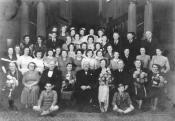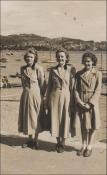Browse the interviews
Sorted by interviewee name
VN055 Beryl Buchanan, Ferranti, Bangor;Hotpoint, Llandudno;Mona Products, Menai Bridge
Beryl went to Mona Products, which made clothes for Marks and Spencers, straight from school in 1958. She was sewing collars and sleeves onto T shirts and putting elastic in knickers and sewing gussets. There wasn't a basic wage and she said you had to work your socks off to make your wage up, the wages were very bad. There were no health and safety regulations and a small canteen. There was only a few men there - two packing, two mechanics and the manager. There was music on the factory floor, and the boys would choose what station they'd listen to - like Workers' Playtime and the news. After two years, she moved to Ferranti, which made electronic meters. This was much bigger than Mona Products and she was working on the laminations and making tops for sports cars and leather covers. She was much happier in Ferranti's, lot more fun, and a better wage plus bonuses. Beryl was there until 1968, when she went to Hotpoint for a few months. She didn't like Hotpoint and returned to Ferranti, getting married around this time and stopping work when she had children.VSW020 Rita Davies & Meirion Campden, Croydon Asbestos, Milford Haven;Myfanwy Products, Gorseinon;Glanarad Shirt Factory, Newcastle Emlyn
Rita and Meirion left school at 14 (1945 and 1949 respectively). Rita started immediately in the shirt factory and left to get married (1954) but returned after three years and Meirion joined her (c.1949-1995). The boss was Johnny Morgan, brother of the owner of J T Morgan’s warehouse, Swansea. The first job was hemming woollen shirts. They had pocket money from their pay packet. The boss would tap them on their heads or pinch them if they talked. Rita worked on the button machine and Meirion made shirts. They had a book to record their work. The factory was taken over by Myfanwy Products, Gorseinon – they made dolls’ clothes and shawls for 2-3 years. Then by Croydon Asbestos making leather gloves (Heavy work) with industrial machines. The older women were kind to them. They had a piece of clothing from the J T Morgan warehouse as a gift every Xmas and a trip to Llandrindod in June. The workers’ numbers were put on each shirt. Meirion had to go to hospital after sewing her finger. Rita went to work in rollers and a turban. Croydon Asbestos closed c.1996.

VSE060 Rosalind Catton, Revlon, Maesteg;New Stylo, Bridgend;Anglomac, Bridgend
Rosalind left school at 15 (1958) and soon went to the Anglomac Factory, which made raincoats. She was in the cutting room – until 18 she could only lay out the fabrics. All the cutters were women. The factory closed (after c.1 year) and she went to the shoe factory. Believes there was a stigma with being a factory girl. The cutting knife could be dangerous. Perks – buying raincoats and got cottons. In New Stylo she decorated the shoes, using a stapling machine attaching trims. Stayed a year again. Bigger factory wirh more facilities. Later when she had children she worked in Revlon (c. 1969) on 10-2 shift – mothers’ shift. Very fast and boring jobs there. One job putting a top on a bottle and hitting it with a mallet. Nonstop so had to be replaced if she wanted to go to the toilet. Some of older women talked a lot about sexual things. She worked intermittently there for a period.VSE067 Christine Chapman, Roller Blind Factory, Llwynypia;Gainsborough Flowers, Porth
Christine’s mother worked in factories e.g. Flex Fasteners and found her part-time holiday jobs. She worked in Gainsborough Flowers when in the sixth form – making artificial flowers on old-fashioned machines. She even worked with a candle! During university she worked in the roller blind factory. She felt some of the women were bitchy – they played tricks on them. She became very efficient in the roller blind factory and the Trade Union person asked her to slow down. Some form of bullying. Bosses talked down to the women. She worked on the presses. Had to have permission to go to the toilet. She worked in the flower factory c.1973-4. Radio on and banter going on all the time. She used to daydream and plan ahead. Risqué stories – repeats one. Talks of some harassment. She was just passing through. She learned a lot about intimidation too – held her in good stead as a politician. How the management treated the women was an early feminist lesson. She’s been in the real world. She talks about her career as a Labour politician.VSE012 Margaret Chislett, The Bag factory, Llwynypia;Polikoff's, Treorchy
Margaret left school at 15 (1937) and worked for a year as a nanny in London before joining Polikoff’s in 1938. There she completed an order for Lady Churchill – overcoats for her Russian fund. Very heavy – wore them to their ankles. Also made uniform for Montgomery’s army in N Africa. She contributed 2d to the Red Cross and 2d to Lady Churchill’s fund out of her wages. Could fill in any job on the line. Hemming the Russian order. 2,500 workers when at its peak. ENSA entertained them. Stayed 9½ years. Her mother bought silk parachute from Tonpentre Co-op to make petticoats and knickers. Union meetings – against Sunday work. Wore bib and braces and slacks for first time. Needle in finger. Radio playing Vera Lynn songs. Friday afternoon cleaned own machines, took pride in them. Factory built for Eastenders because of war. Left when pregnant. Frowned upon for women to work Sundays. Different lines organised social dos. Paid holidays from 1948 onwards. Had to contribute towards Bank Holiday pay. After the war they made de-mob suits. Left 1949. Enjoyed there because she met different kinds of women – chapel going – Bethany Gelli with its drama group, hockey club, very pub going – dancing etc. Later she went to the bag factory in Llwynypia – making bags etc for M&S- again sewing with machine. Then shut down after c. 2 years.Part of this interview is available as an audio file
VSE026 Marjorie Collins, Hitachi, Hirwaun;Lines (Triang), Merthyr;General Electric Company, Merthyr
Her family background. Marjorie went to Technical college and left at 15 (1943) and worked in the Rediffusion office before going to Lines for three months before getting pregnant (1949). Dirty work but enjoyed company. Xmas fun. Returned there (1951). Welding and riveting toy push-chairs. Doing up their home. Told to take it easy in work – spoiling the rate for the men. Men teasing her. Factory (Triang) also made full size prams etc. Singing. Worked in a garage for years then. Then to GEC in Merthyr (?when she was 49 -1977) and then to spotlessly clean Hitachi factory, Hirwaun – full-time. In Merthyr making circuit boards – and likewise in Hitachi but also other jobs there. Japanese boys not allowed to fraternise with local workers. In the beginning Japanese said there were too many ‘white-heads’ there – then realised they were good workers. Younger workers spent time in toilets. Describes the solder bath at GEC. In those days if you didn’t work you were existing not living. She finished when she was 60 (1988).
VSE049 Sandra Cox, JR Freeman's Cigar Factory, Cardiff
Sandra left school at 14 but didn’t start working in the factory until 1973 when she was 22. She describes making the cigars and the smell on their hands. One girls lost the top of her finger in the cutting machine. They had to get as many cigars as possible from one leaf. There was one strike about the heat. Their targets were written on a blackboard in the factory. She travelled on a Vesta scooter to work. There was security to stop staff stealing any. They had ten cigarettes free a week and five cigars + cigarettes at Xmas. She competed to be Miss Freeman, not in swim wear but they were interviewed. She left because she was sacked (or she resigned).VSW008 Sally Cybluski, Parsons Pickles, Burry Port;The Optical, Kidwelly
Sally left school in 1935 aged 14. When she was 18 she was called up and worked on a farm – selling milk in Carmarthen. She fell and broke her back. Then she worked in a wool shop. She talks about her husband who was a prisoner with the Gemans – came to Wales. They got married in 1946. She worked in a pickle factory – awful place. She packed mussels. She saw a piece of paper written by Parsons saying that all the factory girls were lazy. She complained and was sacked. She worked at a cleaners for 10 years, then at the Optical factory, where her husband worked. Describes process of making lenses. The cold – the lenses were kept in a large freezer. They had to do 11 trolley loads a day. It was heavy work; her shoulders and legs have been affected. It was also very noisy and she’s deaf now. They had to buy Swarfega to clean their hands from the company – she tells the story of an Italian stealing it. She tells the story of Wadic, her husband’s illness.VSW011 Augusta Davies, Cardwells, Lampeter;Slimma-Dewhirst, Lampeter
Augusta left school at 16 (1961), worked as a cleaner, married and had a child before starting in Cardwells' in 1965. She was there for 2 years before having another child and returning to Slimma’s (1976-2002). She missed the girls when she finished. In Slimma's they all had targets and they checked on them every two hours. No union in Cardwells' but there was one in Slimma's. Towards the end lots of young lads from school worked as machinists too – pulling their legs. They sang to the music on the radio. No time to talk. She discusses the change from cash payment to paying through the bank. They had trips from both factories, a Xmas part with a turkey and wine as a bonus in Slimma's. Buying seconds. There was a creche in Slimma's – bussing children to Cardigan (c.1990??). She also worked in the Llandovery and Swansea factories. She left because of her arthritis.
VN009 Beti Davies, Woollen Factory, Glyn Ceiriog
Beti worked in the Wool Factory in Glyn Ceiriog straight from school at 14. She also kept house for her father after her mother died shortly before this. She started on the bobbins then moved on to make the material for good quality wool coats that were fashionable at the time. She had a chance to buy one of these coats: “One was camel, and a sort of duck egg blue, oh, a lovely colour, and we had the chance to buy a coat for five pounds. They kept five shillings a week out of our wages until we'd paid the five pounds. And someone told me that those coats were worth twenty five pounds in the shops.” Her sister, Marion, worked there too. Beti left around the time the factory closed and she went to work for the Forestry Commission. She married four years later and had a son, after which she didn't return to work. She also looked after her father until he died, after which she did some part time cleaning work.
